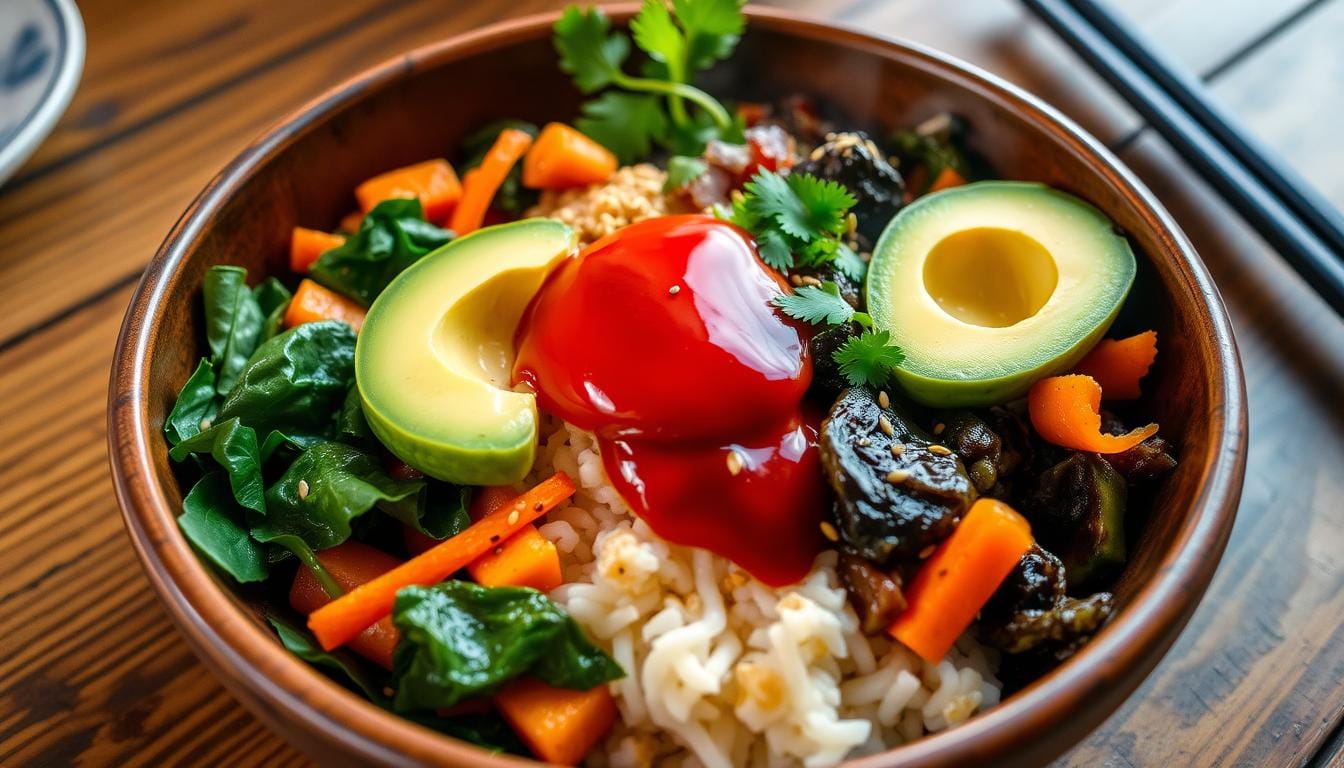Jump to Recipe
When I went to Seoul and tried bibimbap for the first time, the mix of bright, fresh vegetables and the spicy gochujang dressing blew my mind right away. Having transitioned to veganism a few years ago, I was delighted to discover that this traditional Korean dish could effortlessly transform into a vegan culinary masterpiece.
This simple bowl holds a balance of colors, textures, and healthy ingredients that promise both taste and nutrition. Feel free to follow along as I show you how to make this delicious vegan bibimbap with gochujang sauce in your own home.
This plant-based Korean dish is a wonderful example of how healthy and satisfying vegan food can be. The flavors work well together, with the crunchy vegetables and the warming gochujang. Let’s explore the world of healthy vegan food and see how simple and appealing vegan bibimbap is.
Introduction to Vegan Bibimbap
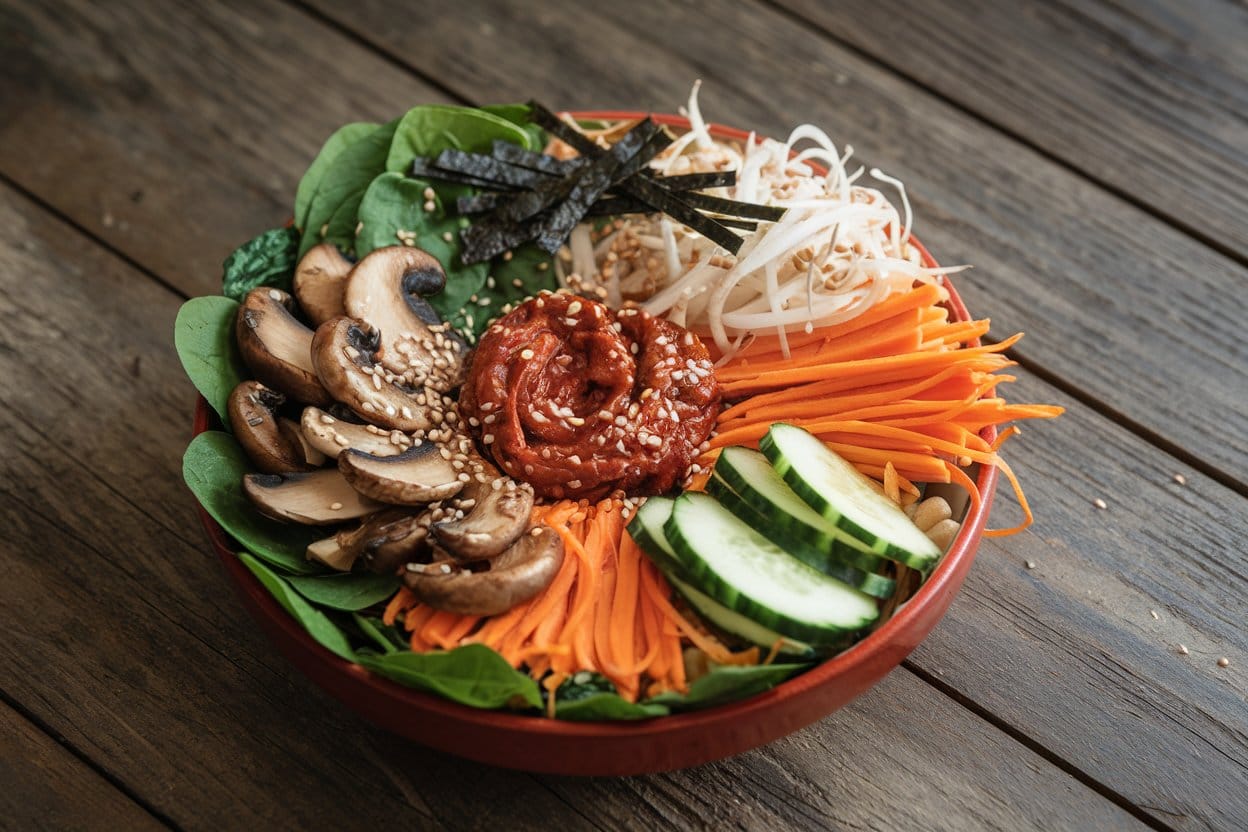
Starting to learn how to cook vegan food can be an exciting culinary adventure. One tasty dish to start with is the Korean bibimbap recipe, which is a traditional bowl of mixed vegetables and meats made with colorful plant-based ingredients.
This idea for a vegan meal is the perfect mix of taste and health. Bibimbap is originally a mix of different vegetables, rice, and a spicy sauce. Typically, people serve it with either an egg or meat. However, the vegan version substitutes meat with a rainbow of fresh vegetables, tofu or tempeh, and a delicious gochujang sauce.
You can tailor this dish to suit a variety of diets, which makes it great. It’s also a beneficial choice for healthy eating. With easy-to-find ingredients and simple cooking steps, this dish is straightforward for even a beginner cook to master.
Bibimbap is an important part of vegan Korean cooking because it has a lot of different tastes and textures that go well together. That being said, this Korean bibimbap recipe is a wonderful place to start if you want to spice up your meals or learn more about vegan food.
This dish looks good because it’s colorful, and it tastes great because it has gochujang sauce, which is rich and full of umami. Get ready to enjoy eating in a way that is healthier, tastes better, and has more life.
Ingredients for Vegan Bibimbap
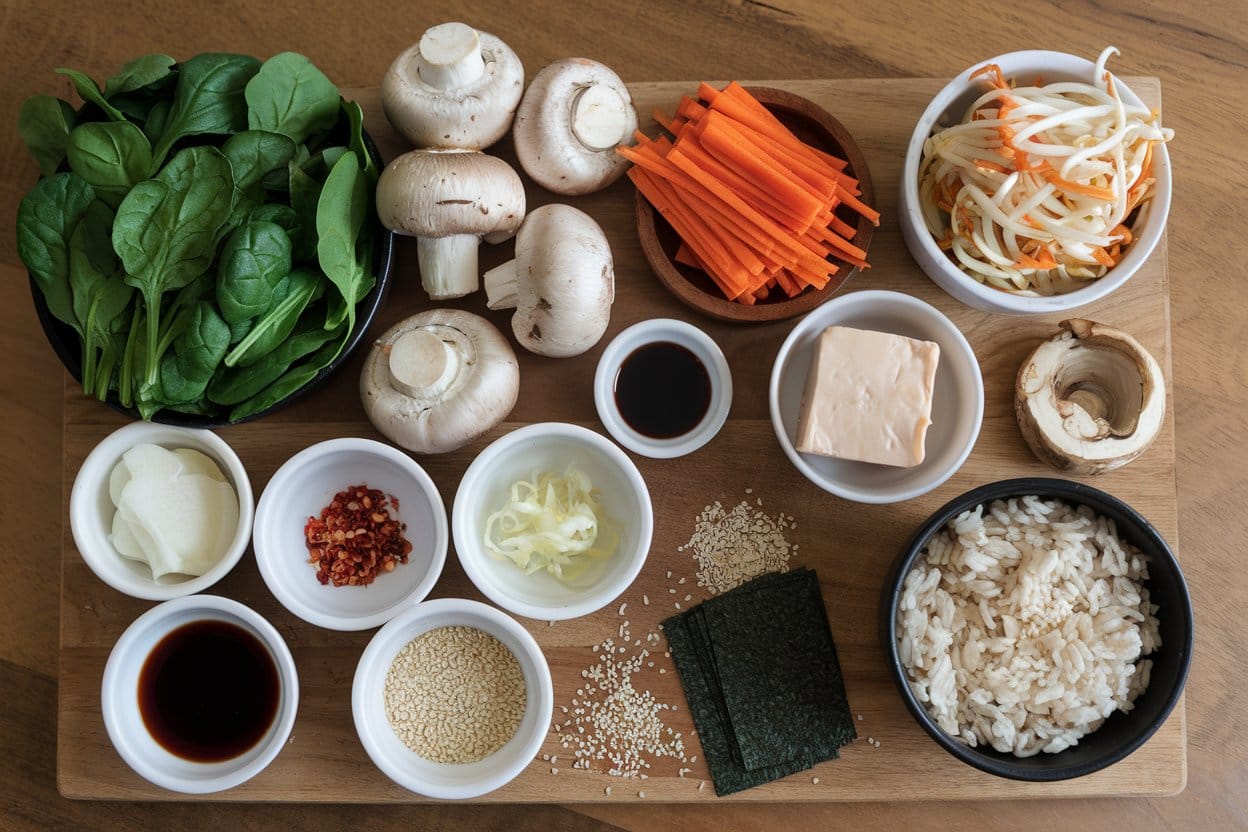
The quality and choice of ingredients are very important for making tasty vegan bibimbap. Every part of the meal is important for making it healthy and balanced, from the bright, fresh vegetables to the hearty vegan toppings and of course, the traditional Korean rice dish.
Key Vegetables to Use
The main part of vegan bibimbap is a mix of fresh vegetables that give the dish color and health benefits. Most people choose:
- Spinach: Very briefly blanched, this green vegetable has a mild, earthy taste and is full of vitamins.
- Shiitake mushrooms: sautéed to make them taste more umami-rich.
- Carrots: cut into thin slices and cooked just enough to keep their bright color and crisp texture.
- Bean sprouts: These little crunchy, fresh sprouts have a mildly nutty flavor.
Essential Toppings
Healthy vegan toppings are an important part of a Korean rice dish because they add the perfect finishing touch.
- Kimchi: The fermented cabbage gives it a tangy flavor.
- Nori (seaweed): thin strips that provide a taste of the ocean.
- Sliced cucumbers provide freshness and crunch to balance out other textures.
- Sesame Seeds: A decorative sprinkle that gives food a nutty flavor.
Perfect Rice Base
Rice forms the foundation of any authentic Korean rice dish. For Vegan Bibimbap, you want a bowl of fluffy, steamed rice that will hold its own under an array of toppings. People usually choose short-grain white rice because it has a slightly sticky texture that goes well with the vegetables and sauces.
How to Prepare Gochujang Sauce
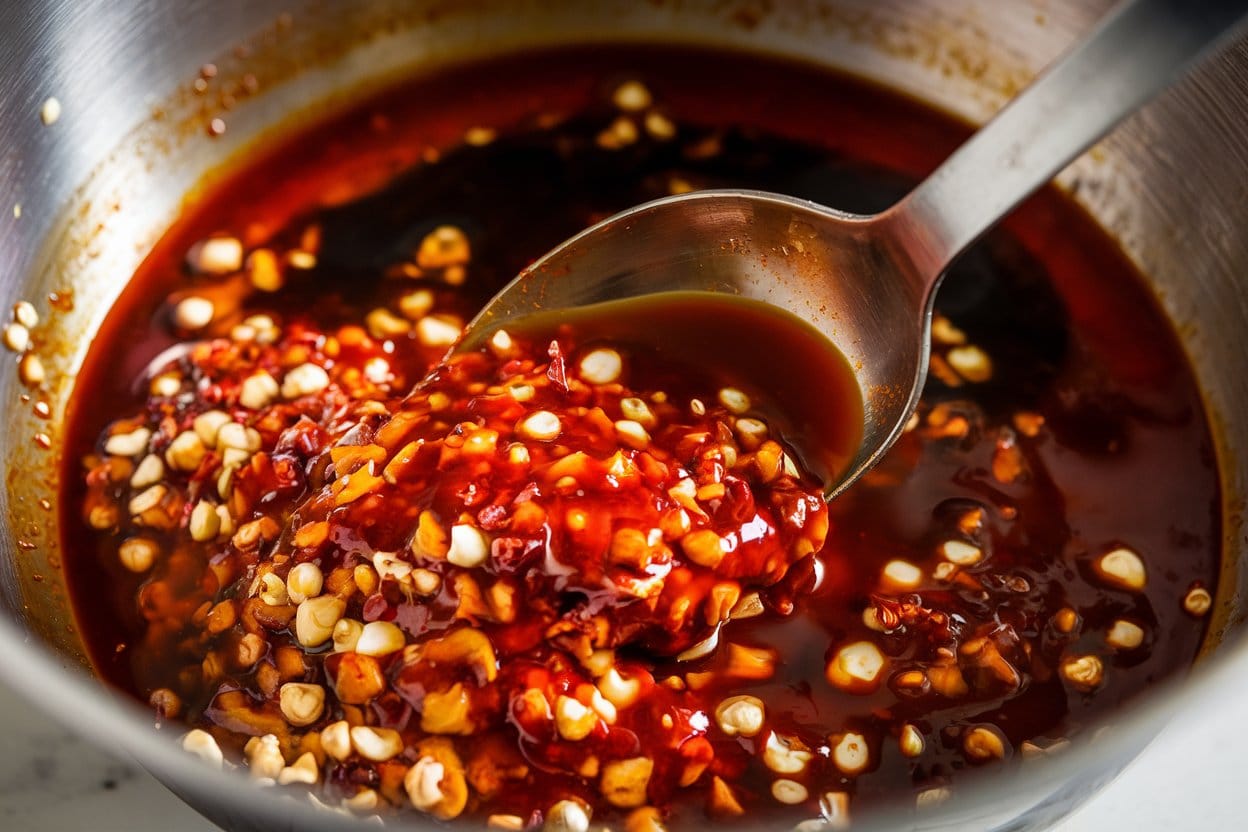
In Korean spice blends, gochujang sauce is a main ingredient. It adds a spicy, umami-rich flavor to many dishes. It’s simple to make a vegan version at home; you just need a few key ingredients and steps. Let’s delve into how to make this delicious Asian condiment at home.
Ingredients for Gochujang Sauce
Before you begin making the gochujang sauce, prepare the following ingredients:
- 1/2 cup Korean red pepper flakes (Gochugaru)
- Add 3 tablespoons of sweeteners, such as maple syrup or brown rice syrup.
- 1/4 cup soy sauce or tamari (for a gluten-free option)
- 2 tbsp rice vinegar
- 2 tablespoons miso paste (preferably red)
- 1 tbsp garlic, minced
- 1 teaspoon . minced ginger
- 1 teaspoon salt
These ingredients work well together to make a bright, spicy vegan sauce that is ideal for vegan sauce recipes.
Steps to Make Gochujang Sauce
To create your own Korean spice mix, follow these steps:
- Place the Korean red pepper flakes and sweeteners into a medium-sized bowl. Mix well until everything is well mixed.
- As you add the soy sauce or tamari slowly, make sure the mixture stays smooth.
- Add the miso paste, garlic, ginger, and salt. Make sure to thoroughly mix all the ingredients together.
- If your sauce tastes too hot, add more red pepper flakes or sweeteners to make it taste better.
- Put the gochujang sauce in a container that won’t let air in and place it in the fridge. The flavors will get stronger over time as it sits for up to a month, the flavors will become stronger.
This Asian condiment that you can make at home is full of flavor and spice, and it will give your food a real Korean touch. You can enjoy making gochujang sauce knowing that you’ve prepared a vegan version that tastes just as good.
Steps to Assemble Vegan Bibimbap with Gochujang Sauce
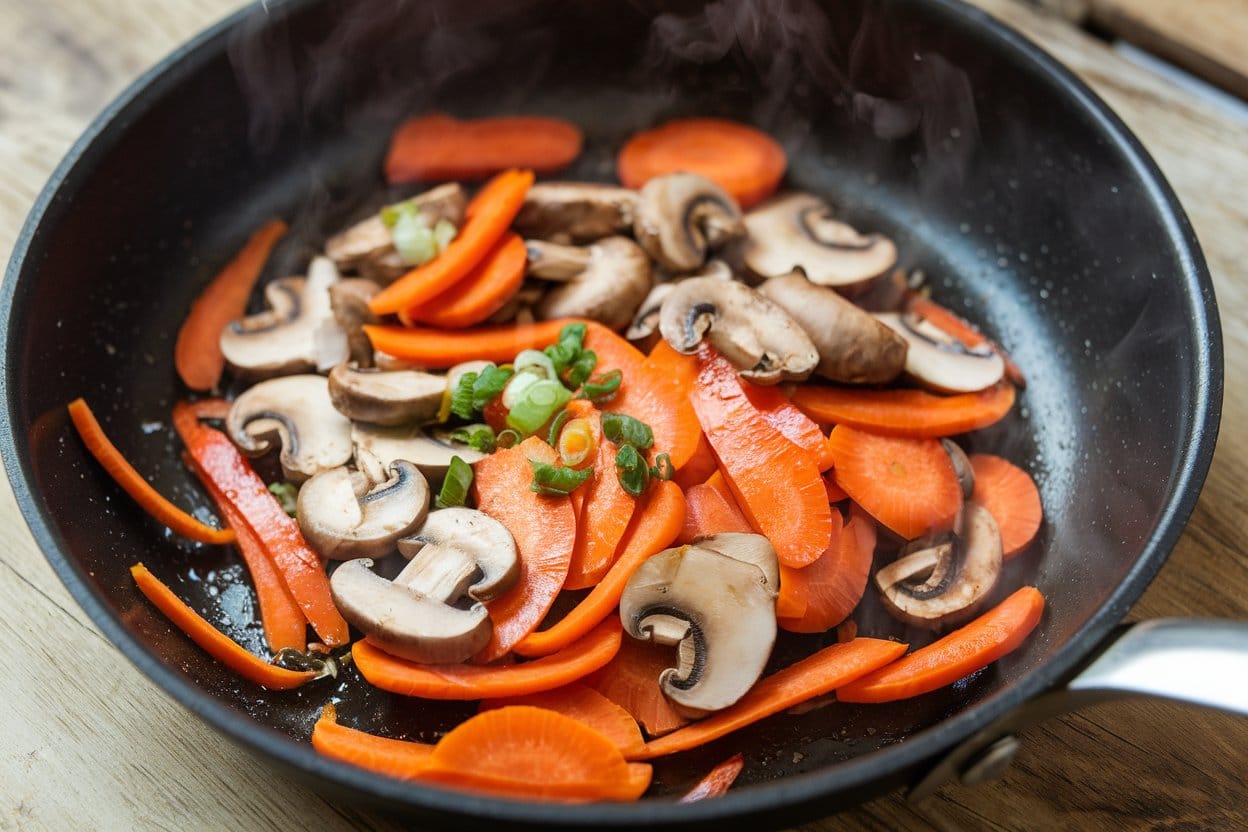
Putting together vegan bibimbap is an art that combines many different Korean cooking styles with creative ways to present the food. Here is my step-by-step guide to making delicious and beautiful vegan dishes that everyone will enjoy.
- Get your base ready: First, put your perfectly cooked rice in a bowl and spread it out. The rice is the base of your bibimbap. It has a mild, neutral flavor that goes well with the toppings.
- Layer the Vegetables: Put your cooked vegetables, like spinach, carrots, mushrooms, and bean sprouts, in a circle shape that is full of different colors. Blanch or sauté each vegetable briefly using traditional Korean cooking methods to make sure they keep their nutrients and bright colors.
- Toppings That Make It Taste Better: To add more texture and flavor, add toppings like toasted sesame seeds, nori strips, and fresh cucumber. Food tastes and looks better with these toppings.
- Add the star ingredient, gochujang sauce, to the dish: Spread a large amount of your homemade Gochujang sauce over the vegan bibimbap that you’ve put together. Its spicy-sweet flavor will make all of the parts work well together.
- Last touches: Add a little sesame oil and spring onions on top of the vegan dish to make it taste better. These small additions can greatly improve the taste.
Remember that the fun of making vegan bibimbap comes from being creative with it. The goal is to make the flavors go well together and make it look good, whether you serve it in a traditional stone bowl or a regular dinner plate. Have fun trying out different cooking methods and ingredients to make this dish truly your own.
Tips and Tricks for the Perfect Vegan Bibimbap
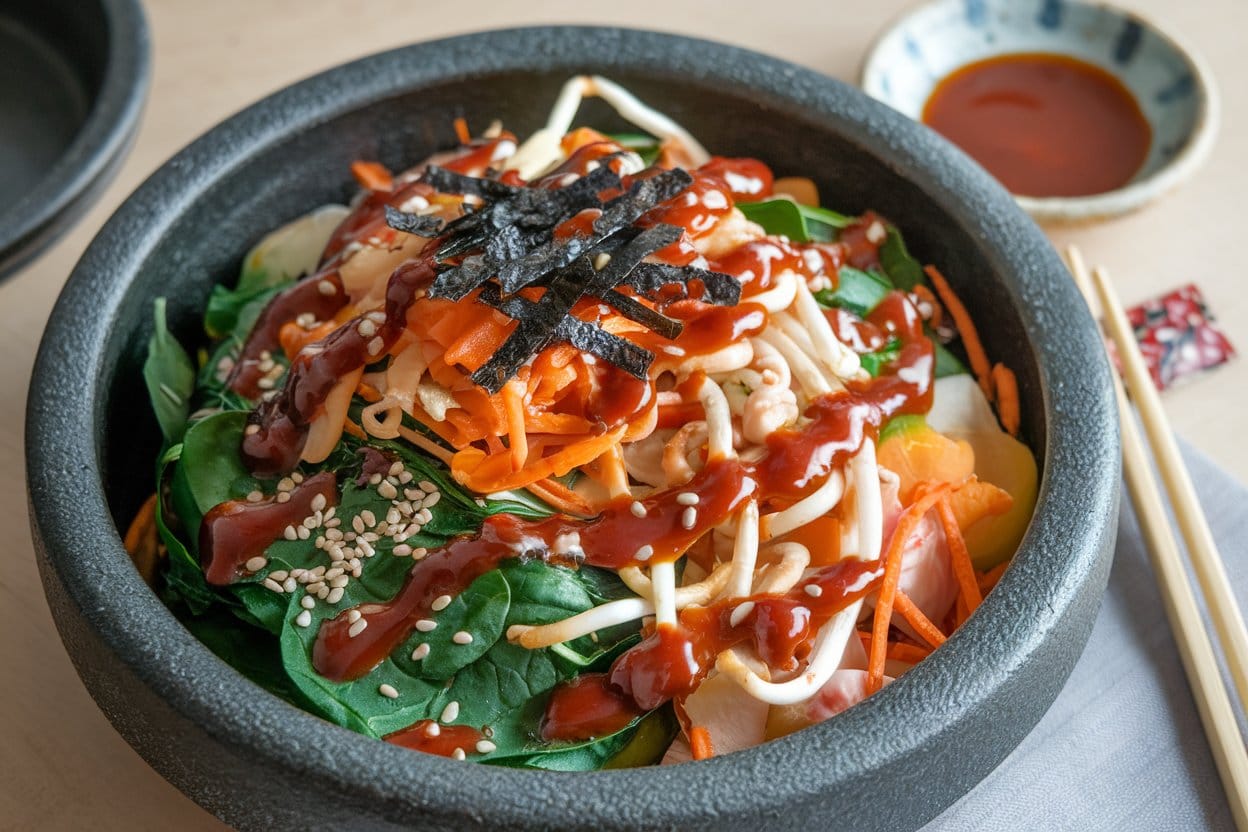
It takes more than just following a recipe to make the perfect vegan bibimbap. You need to know what the key ingredients are and how to use them. Here are some important tips that will help you make your dish stand out and bring out the flavors.
Balancing Flavours
It is important to find the right balance between the six basic tastes: sweetness, sourness, bitterness, savory, spiciness, and saltiness. If your dish is too spicy, add a little rice syrup to make it a little sweeter. A splash of lime or lemon juice can balance it out if it’s too salty.
Keep in mind that the beauty of a perfect vegan bibimbap lies in getting all of these flavors to work well together so that they suit your taste.
Cooking Tips
Getting the rice just right is key to making a good bibimbap. To follow traditional Korean cooking methods, you should rinse the rice well to get rid of any extra starch. To make it fluffy, cook it with enough water.
Also, don’t forget how important it is to sauté your vegetables well. They will taste better and have more texture if you quickly sauté them over high heat so they stay crisp and orange.
Serving Suggestions
It’s not just about how delicious vegan meals like bibimbap taste; it’s also about how they look. A traditional stone bowl, called a “dolsot,” keeps the food warm and can make the rice at the bottom crispy, which is very tasty.
Put the vegetables around the rice in a colorful, circular pattern to make the dish look good. Additionally, providing extra gochujang sauce on the side allows everyone to choose how spicy they like it. These little things can make the dining experience a lot better.
Conclusion
Thinking back on my journey in the kitchen to make vegan bibimbap with gochujang sauce makes me feel happy and accomplished. The colorful and varied ingredients not only show what vegan food can be like, but they also add a fun twist to the usual healthy Korean style of eating.
This dish shows how being creative in the kitchen can lead to tasty, healthy meals that your whole family will love. We’ve gone from choosing the important vegetables and making the perfect rice base to mixing the tasty gochujang treats.
This guide gives you the information you need to make this delicious dish again. Furthermore, it encourages you to try new things and make them your own, creating your own variations and fully embracing vegan food on a deeper level.
In the end, I want you to dive into this world of bright plates and tasty flavors. To me, vegan bibimbap is more than just a meal. It’s an exploration of rich flavors and proof of how versatile plant-based food can be.
Start this journey because it’s beneficial for your health, it’s the right thing to do, and most of all, it brings joy to your table. Here’s to a hearty, flavorful journey through the world of vegan treats!

Vegan Bibimbap with Gochujang Sauce
Ingredients
Method
- Cook the Rice: Rinse 1 cup of short-grain rice under cold water until the water runs clear. Cook the rice using the absorption method or a rice cooker until fluffy and slightly sticky.
- Prepare the Vegetables:
- Blanch the spinach and bean sprouts for 1-2 minutes in boiling water, then drain.
- Sauté the shiitake mushrooms and sliced carrots in a little sesame oil until softened.
- Make the Gochujang Sauce:
- In a medium bowl, mix together the Korean red pepper flakes, maple syrup, soy sauce, rice vinegar, miso paste, garlic, ginger, and salt. Stir until smooth and combined. Adjust sweetness and spice to taste.
- Assemble the Bowl:
- Divide the cooked rice into bowls. Arrange the prepared vegetables (spinach, mushrooms, carrots, bean sprouts, cucumbers, and kimchi if using) in sections around the rice.
- Top It Off:
- Add a generous spoonful of gochujang sauce over the top. Garnish with sesame seeds and nori strips.
- Final Touches:
- Drizzle a bit of sesame oil on top and enjoy mixing everything together before eating.
Notes
- Feel free to substitute tofu or tempeh for added protein.
- Adjust the spice level in the gochujang sauce by adding or reducing the red pepper flakes or maple syrup for balance.
- You can add avocado or extra kimchi for more flavor and creaminess.
FAQ
What is Vegan Bibimbap with Gochujang Sauce?
A colorful blend of vegetables and rice forms the base of Vegan Bibimbap with Gochujang Sauce, a vegan Korean dish. Gochujang Sauce, a spicy, sweet, and savory sauce, tops it. This vegan version maintains traditional Korean flavors while also being good for people trying to live a vegan life.
What are the key ingredients in Vegan Bibimbap?
Fresh vegetables like spinach, mushrooms, and carrots, important toppings like kimchi and nori, and a delicious rice base are what make Vegan Bibimbap what it is. Each ingredient adds to the dish’s nutritional value and flavor as a whole.
How do I make the Gochujang Sauce vegan?
To make vegan Gochujang Sauce, you’ll need things like maple syrup, red pepper flakes, soy sauce or tamari, and other vegan-friendly sauces and condiments. The sauce is created by combining these ingredients and adjusting them to achieve the desired heat and flavor.
What is the origin of Bibimbap?
This is a traditional Korean dish called bibimbap, which means “mixed rice.” Typically, it consists of a variety of different vegetables, rice, and a spicy sauce. While keeping the dish’s original look and taste, this vegan version adds a plant-based twist.
Can beginners in vegan cooking make Vegan Bibimbap?
Of course! This dish is ideal for beginners because it uses simple ingredients and straightforward cooking methods. The article shows how to make vegan Korean food step-by-step, so even people who have never cooked before can do it.
How should I serve Vegan Bibimbap?
To serve vegan bibimbap, you need to arrange the ingredients in a bowl in a pretty way, and then pour Gochujang sauce on top. Using traditional stone bowls or regular dinnerware, distributing flavors evenly, and plating food properly can enhance the enjoyment of the meal.
What are some tips for balancing the flavours in Vegan Bibimbap?
To get the right balance of flavors in Vegan Bibimbap, you need to change the six main tastes: sweet, sour, bitter, savory, spicy, and salty. Play around with different amounts to find the right balance for a tasty and satisfying meal.
What are some cooking tips for making the perfect vegan bibimbap?
For example, to cook the rice to the right consistency, make sure all the vegetables are sauté-perfect, and all the ingredients are fresh and full of flavor. Using these tips, you can make Bibimbap that tastes great and is good for you.
Are there any serving suggestions to make vegan bibimbap more impressive?
Tips for serving vegan bibimbap include making it look nice by using a variety of colorful vegetables, coming up with creative ways to plate it, and giving extra toppings like avocado or sesame seeds. These little touches can make your meal more enjoyable and impress your guests.

